Juho Kannala
Aalto University, Espoo, Finland, University of Oulu, Oulu, Finland
Evaluating Fisheye-Compatible 3D Gaussian Splatting Methods on Real Images Beyond 180 Degree Field of View
Aug 09, 2025Abstract:We present the first evaluation of fisheye-based 3D Gaussian Splatting methods, Fisheye-GS and 3DGUT, on real images with fields of view exceeding 180 degree. Our study covers both indoor and outdoor scenes captured with 200 degree fisheye cameras and analyzes how each method handles extreme distortion in real world settings. We evaluate performance under varying fields of view (200 degree, 160 degree, and 120 degree) to study the tradeoff between peripheral distortion and spatial coverage. Fisheye-GS benefits from field of view (FoV) reduction, particularly at 160 degree, while 3DGUT remains stable across all settings and maintains high perceptual quality at the full 200 degree view. To address the limitations of SfM-based initialization, which often fails under strong distortion, we also propose a depth-based strategy using UniK3D predictions from only 2-3 fisheye images per scene. Although UniK3D is not trained on real fisheye data, it produces dense point clouds that enable reconstruction quality on par with SfM, even in difficult scenes with fog, glare, or sky. Our results highlight the practical viability of fisheye-based 3DGS methods for wide-angle 3D reconstruction from sparse and distortion-heavy image inputs.
Smoothing Slot Attention Iterations and Recurrences
Aug 07, 2025Abstract:Slot Attention (SA) and its variants lie at the heart of mainstream Object-Centric Learning (OCL). Objects in an image can be aggregated into respective slot vectors, by \textit{iteratively} refining cold-start query vectors, typically three times, via SA on image features. For video, such aggregation is \textit{recurrently} shared across frames, with queries cold-started on the first frame while transitioned from the previous frame's slots on non-first frames. However, the cold-start queries lack sample-specific cues thus hinder precise aggregation on the image or video's first frame; Also, non-first frames' queries are already sample-specific thus require transforms different from the first frame's aggregation. We address these issues for the first time with our \textit{SmoothSA}: (1) To smooth SA iterations on the image or video's first frame, we \textit{preheat} the cold-start queries with rich information of input features, via a tiny module self-distilled inside OCL; (2) To smooth SA recurrences across all video frames, we \textit{differentiate} the homogeneous transforms on the first and non-first frames, by using full and single iterations respectively. Comprehensive experiments on object discovery, recognition and downstream benchmarks validate our method's effectiveness. Further analyses intuitively illuminate how our method smooths SA iterations and recurrences. Our code is available in the supplement.
Slot Attention with Re-Initialization and Self-Distillation
Jul 31, 2025Abstract:Unlike popular solutions based on dense feature maps, Object-Centric Learning (OCL) represents visual scenes as sub-symbolic object-level feature vectors, termed slots, which are highly versatile for tasks involving visual modalities. OCL typically aggregates object superpixels into slots by iteratively applying competitive cross attention, known as Slot Attention, with the slots as the query. However, once initialized, these slots are reused naively, causing redundant slots to compete with informative ones for representing objects. This often results in objects being erroneously segmented into parts. Additionally, mainstream methods derive supervision signals solely from decoding slots into the input's reconstruction, overlooking potential supervision based on internal information. To address these issues, we propose Slot Attention with re-Initialization and self-Distillation (DIAS): $\emph{i)}$ We reduce redundancy in the aggregated slots and re-initialize extra aggregation to update the remaining slots; $\emph{ii)}$ We drive the bad attention map at the first aggregation iteration to approximate the good at the last iteration to enable self-distillation. Experiments demonstrate that DIAS achieves state-of-the-art on OCL tasks like object discovery and recognition, while also improving advanced visual prediction and reasoning. Our code is available on https://github.com/Genera1Z/DIAS.
NVSMask3D: Hard Visual Prompting with Camera Pose Interpolation for 3D Open Vocabulary Instance Segmentation
Apr 20, 2025Abstract:Vision-language models (VLMs) have demonstrated impressive zero-shot transfer capabilities in image-level visual perception tasks. However, they fall short in 3D instance-level segmentation tasks that require accurate localization and recognition of individual objects. To bridge this gap, we introduce a novel 3D Gaussian Splatting based hard visual prompting approach that leverages camera interpolation to generate diverse viewpoints around target objects without any 2D-3D optimization or fine-tuning. Our method simulates realistic 3D perspectives, effectively augmenting existing hard visual prompts by enforcing geometric consistency across viewpoints. This training-free strategy seamlessly integrates with prior hard visual prompts, enriching object-descriptive features and enabling VLMs to achieve more robust and accurate 3D instance segmentation in diverse 3D scenes.
FIORD: A Fisheye Indoor-Outdoor Dataset with LIDAR Ground Truth for 3D Scene Reconstruction and Benchmarking
Apr 02, 2025Abstract:The development of large-scale 3D scene reconstruction and novel view synthesis methods mostly rely on datasets comprising perspective images with narrow fields of view (FoV). While effective for small-scale scenes, these datasets require large image sets and extensive structure-from-motion (SfM) processing, limiting scalability. To address this, we introduce a fisheye image dataset tailored for scene reconstruction tasks. Using dual 200-degree fisheye lenses, our dataset provides full 360-degree coverage of 5 indoor and 5 outdoor scenes. Each scene has sparse SfM point clouds and precise LIDAR-derived dense point clouds that can be used as geometric ground-truth, enabling robust benchmarking under challenging conditions such as occlusions and reflections. While the baseline experiments focus on vanilla Gaussian Splatting and NeRF based Nerfacto methods, the dataset supports diverse approaches for scene reconstruction, novel view synthesis, and image-based rendering.
A Dataset for Semantic Segmentation in the Presence of Unknowns
Mar 28, 2025Abstract:Before deployment in the real-world deep neural networks require thorough evaluation of how they handle both knowns, inputs represented in the training data, and unknowns (anomalies). This is especially important for scene understanding tasks with safety critical applications, such as in autonomous driving. Existing datasets allow evaluation of only knowns or unknowns - but not both, which is required to establish "in the wild" suitability of deep neural network models. To bridge this gap, we propose a novel anomaly segmentation dataset, ISSU, that features a diverse set of anomaly inputs from cluttered real-world environments. The dataset is twice larger than existing anomaly segmentation datasets, and provides a training, validation and test set for controlled in-domain evaluation. The test set consists of a static and temporal part, with the latter comprised of videos. The dataset provides annotations for both closed-set (knowns) and anomalies, enabling closed-set and open-set evaluation. The dataset covers diverse conditions, such as domain and cross-sensor shift, illumination variation and allows ablation of anomaly detection methods with respect to these variations. Evaluation results of current state-of-the-art methods confirm the need for improvements especially in domain-generalization, small and large object segmentation.
Vector-Quantized Vision Foundation Models for Object-Centric Learning
Feb 27, 2025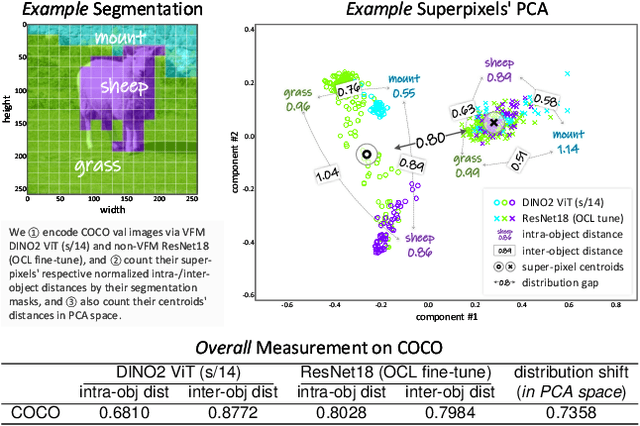



Abstract:Decomposing visual scenes into objects, as humans do, facilitates modeling object relations and dynamics. Object-Centric Learning (OCL) achieves this by aggregating image or video feature maps into object-level feature vectors, known as \textit{slots}. OCL's self-supervision via reconstructing the input from slots struggles with complex textures, thus many methods employ Vision Foundation Models (VFMs) to extract feature maps with better objectness. However, using VFMs merely as feature extractors does not fully unlock their potential. We propose Vector-Quantized VFMs for OCL (VQ-VFM-OCL, or VVO), where VFM features are extracted to facilitate object-level information aggregation and further quantized to strengthen supervision in reconstruction. Our VVO unifies OCL representatives into a concise architecture. Experiments demonstrate that VVO not only outperforms mainstream methods on object discovery tasks but also benefits downstream tasks like visual prediction and reasoning. The source code is available in the supplement.
A2-GNN: Angle-Annular GNN for Visual Descriptor-free Camera Relocalization
Feb 27, 2025Abstract:Visual localization involves estimating the 6-degree-of-freedom (6-DoF) camera pose within a known scene. A critical step in this process is identifying pixel-to-point correspondences between 2D query images and 3D models. Most advanced approaches currently rely on extensive visual descriptors to establish these correspondences, facing challenges in storage, privacy issues and model maintenance. Direct 2D-3D keypoint matching without visual descriptors is becoming popular as it can overcome those challenges. However, existing descriptor-free methods suffer from low accuracy or heavy computation. Addressing this gap, this paper introduces the Angle-Annular Graph Neural Network (A2-GNN), a simple approach that efficiently learns robust geometric structural representations with annular feature extraction. Specifically, this approach clusters neighbors and embeds each group's distance information and angle as supplementary information to capture local structures. Evaluation on matching and visual localization datasets demonstrates that our approach achieves state-of-the-art accuracy with low computational overhead among visual description-free methods. Our code will be released on https://github.com/YejunZhang/a2-gnn.
Generalist World Model Pre-Training for Efficient Reinforcement Learning
Feb 26, 2025Abstract:Sample-efficient robot learning is a longstanding goal in robotics. Inspired by the success of scaling in vision and language, the robotics community is now investigating large-scale offline datasets for robot learning. However, existing methods often require expert and/or reward-labeled task-specific data, which can be costly and limit their application in practice. In this paper, we consider a more realistic setting where the offline data consists of reward-free and non-expert multi-embodiment offline data. We show that generalist world model pre-training (WPT), together with retrieval-based experience rehearsal and execution guidance, enables efficient reinforcement learning (RL) and fast task adaptation with such non-curated data. In experiments over 72 visuomotor tasks, spanning 6 different embodiments, covering hard exploration, complex dynamics, and various visual properties, WPT achieves 35.65% and 35% higher aggregated score compared to widely used learning-from-scratch baselines, respectively.
Advances in Multimodal Adaptation and Generalization: From Traditional Approaches to Foundation Models
Jan 30, 2025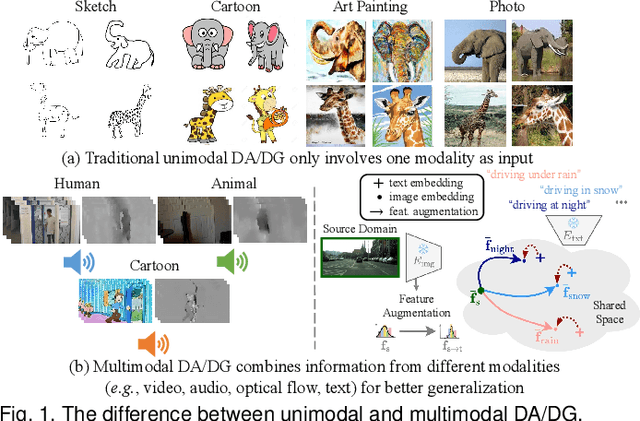
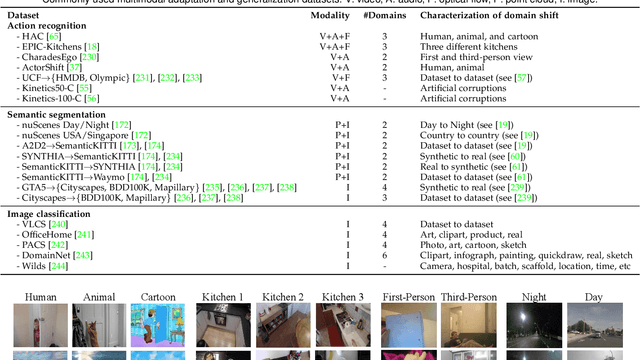
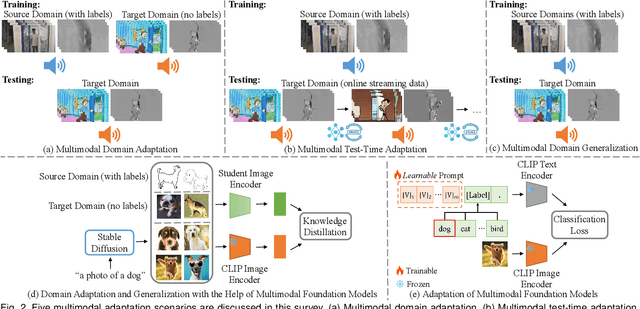
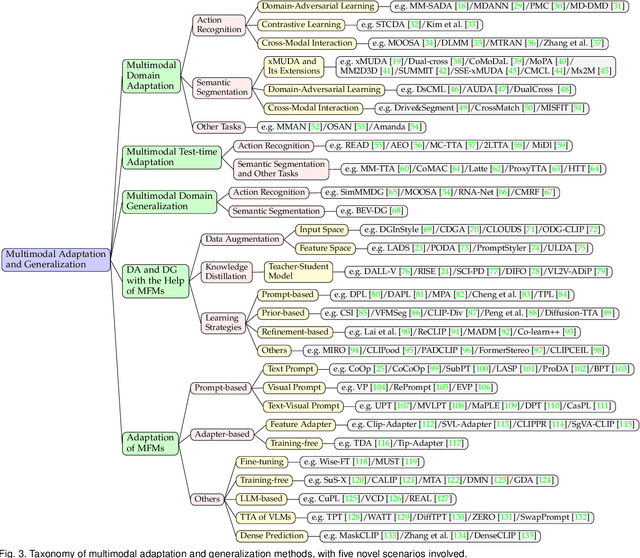
Abstract:In real-world scenarios, achieving domain adaptation and generalization poses significant challenges, as models must adapt to or generalize across unknown target distributions. Extending these capabilities to unseen multimodal distributions, i.e., multimodal domain adaptation and generalization, is even more challenging due to the distinct characteristics of different modalities. Significant progress has been made over the years, with applications ranging from action recognition to semantic segmentation. Besides, the recent advent of large-scale pre-trained multimodal foundation models, such as CLIP, has inspired works leveraging these models to enhance adaptation and generalization performances or adapting them to downstream tasks. This survey provides the first comprehensive review of recent advances from traditional approaches to foundation models, covering: (1) Multimodal domain adaptation; (2) Multimodal test-time adaptation; (3) Multimodal domain generalization; (4) Domain adaptation and generalization with the help of multimodal foundation models; and (5) Adaptation of multimodal foundation models. For each topic, we formally define the problem and thoroughly review existing methods. Additionally, we analyze relevant datasets and applications, highlighting open challenges and potential future research directions. We maintain an active repository that contains up-to-date literature at https://github.com/donghao51/Awesome-Multimodal-Adaptation.
 Add to Chrome
Add to Chrome Add to Firefox
Add to Firefox Add to Edge
Add to Edge